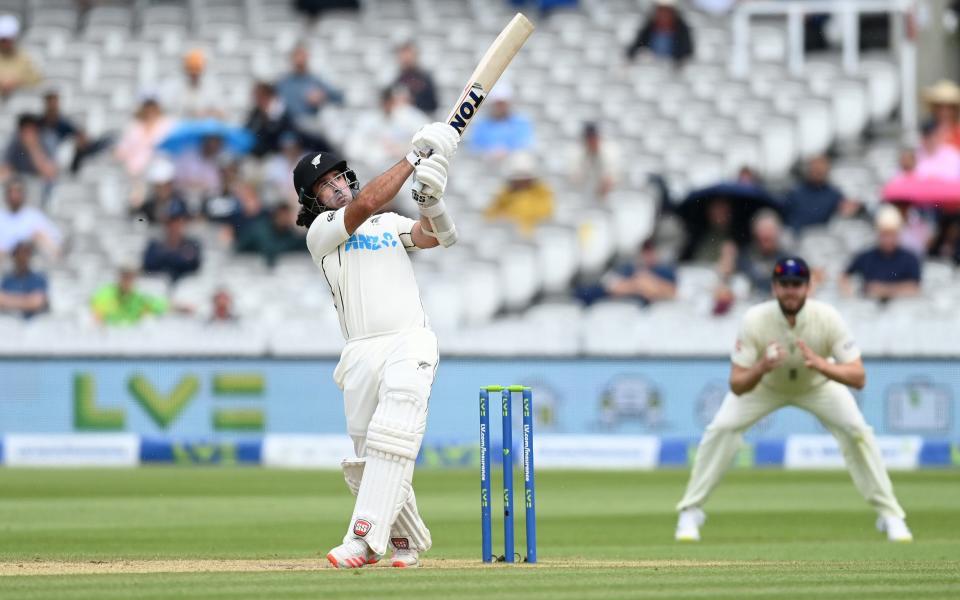World Test Championship final has happened before in all but name - with curious parallels to today

Little in life being completely original, there has been a World Test Championship final before. All the Test countries in the world participated, if only three, and the final was at the Oval in August 1912 between England and Australia.
Then, as now with the match between India and New Zealand, the final was scheduled to last up to six days if required. The major difference lies in the qualifying process.
Australia, England and South Africa played three Tests against each other in England that summer. As both Australia and England thumped South Africa – and drew the first two Tests between each other – the last match was proclaimed to be the final by the Imperial Cricket Conference, as the International Cricket Council then was: the World Test Championship final in all but name.
On the surface, nothing much has changed in the state of English batting. In the final, having won the toss, England scored 245 and 175 – much the same totals as they assembled in their two-Test series against New Zealand.
But as it had rained all night before the Oval final, and the pitch was not covered and therefore turned into a mud heap, these totals were match-winning. Indeed, at the end of the 1912 season the Editor of Wisden was to write of England’s batting that summer: “The run-getting was so consistent that on no occasion was there cause for anxiety.” What bliss to have lived in such an era!
Just how difficult batting was on damp pitches was illustrated by a single ball from England’s best bowler Sydney Barnes (who took 39 wickets at 10 runs each in England’s six Tests in the Triangular) to Australia’s best batsman, Warren Bardsley, a lefthander. The ball pitched “well outside his leg stump” according to Wisden, so Bardsley “let it alone… and the ball turning very sharply hit the leg stump.” Here was a completely different sport: much less physical, but no less skilled, and even more so in some respects, like spin bowling and batting against it.
England were so strong in batting largely because they had installed their first regular opening pair in Jack Hobbs and Wilfred Rhodes. Again, utterly unlike today, their partnership was not based on going for big shots at wide balls but on their running between wickets.
Hobbs and Rhodes kept the scoreboard ticking over with quick singles – even though, Wisden states, the Australians’ fielding was “superb”. “Thanks to constant association in South Africa and Australia the two men understood each other so well that they could with safety attempt short runs that in ordinary circumstances would have savoured of madness.”
The last England pair of Test batsmen to pressurise the opposition in this way, looking for quick singles and running fast between wickets? Jonny Bairstow and Joe Root.
England were ahead from the moment Hobbs and Rhodes put on 107 for the first wicket. The outfield was so damp that Hobbs hit only four fours, but such was his speed between wickets he ran seven threes as well as those quick singles.
Hobbs’ USP was being so light on his feet: he moved on to his back foot and pulled when the ball plugged on a wet pitch and sat up. His fielding was based on the same characteristic: Bardsley in his second innings fell into the trap of thinking a single could be had to Hobbs at cover and was run out by a direct hit. On one tour of Australia, before analysis and video highlights were alerting the world, Hobbs ran out 15 batsmen from cover.
The rest of this final is quickly told. Frank Woolley played some big shots for England to post 245, and helped Barnes to dismiss Australia for 111 between more showers.
Batting had become so awkward by England’s second innings that at one stage an edge for three was the only scoring shot in eight overs. But they scraped together enough – as English batsmen tend to do on bad pitches, even today – and reached 175
Needing 310 to win the final, Australia were dismissed for 65 just before the close of day four, England winning by 244 runs. Only just in time too, as the last two days saw incessant rain: as the Wisden Editor observed, 1912 was “one of the most appalling summers ever known, even in England.”
And it was this rain as much as anything which ruined the Triangular Tournament: a reminder that any new cricket tournament in England, like the Hundred, hinges on the weather. Nobody wanted to watch Australia vs South Africa in the rain. “The result is that the experiment is not likely to be repeated for many years to come – perhaps not in this generation,” the Wisden Editor, Sydney Pardon, prophesied.
After the events at Edgbaston last week, it has to be said that it is just as well that England are not involved in the WTC final at Southampton. How their current batting would fare against New Zealand’s first XI, or India, does not bear thinking about. Yet it will be England’s title as Test champions that India or New Zealand inherit, all of 109 years later.
Where the World Test Championship will be won
By Tim Wigmore
Team philosophies and balance
One fascination of the final is that the two best Test sides in the world embrace profoundly contrasting styles. New Zealand’s success is built upon their mastery of Test cricket’s boring bits; India play with altogether more enterprise and flair. In many ways, both sides adopt the spirit of their captains, Kane Williamson and Virat Kohli: two modern masters, just in very different ways.
There is also a marked difference in the balance of the two attacks. India’s XI will include two spinners and three quicks; New Zealand are weighing up between a five-man seam attack and selecting Ajaz Patel as the lone spinner.
Yet there is a strong case that New Zealand should double down on their seam attack, which is still a varied attack, even if not in the traditional way. New Zealand’s template against India last year showed how effective their seam attack can be even after the new ball has lost its shine - their seamers averaged a remarkable 13.8 after the 30th over in the series - as England could also attest.

Playing the moving ball
One of the traits of the Dukes ball is that it swings appreciably more than the Kookaburra. Indeed, New Zealand’s victory over England was underpinned by lavish swing movement. Yet, for all the excellence of New Zealand’s quick bowlers, India have become adept at playing the swinging ball: since 2016, India’s top seven average 37.4 against the swinging ball, the best average of any nation. Not that New Zealand are particularly susceptible to swing either: their top seven average 35.3 against swing in this time.
Just as was the case during the 4-1 defeat in England in 2018, India’s weakness against the moving ball has tended to be against seam rather than swing. Since 2016, India’s top seven average a comparatively modest 32 against deliveries that seam more than 0.5 degrees. New Zealand lead the way in this time, averaging 36. Seam determining the fate of the inaugural World Test Championship - just as it did New Zealand’s 2-0 victory at home to India last year - might offer New Zealand their best chance.
Match-ups
The variety in both bowling attacks may allow them to exploit batsmen’s specific weaknesses. Indian batsmen are generally outstanding against spin, but even if New Zealand select an all-seam attack it will be a contrasting one. Curiously, all of India’s top six fare better against right-armers than left-armers; in some cases the differences are pronounced. Openers Shubman Gill and Rohi Sharma average 18.9 and 34.1 against right-arm quicks; Gill has scored 94 runs against left-armers without being dismissed, while Sharma averages 135 against left-armers. Perhaps New Zealand could be minded to whisk Trent Boult out of the attack early. Kyle Jamieson, being 6ft 8in, offers an essential point of difference - Cheteshwar Pujara particularly struggles against bowlers of such height, and was twice dismissed by Jamieson last year.
India, with both a left-arm spinner and off spinner, will try and manipulate the bowling to turn the ball away from the bat as much as possible. This could see Ashwin enter the attack early, against New Zealand’s two left-handed openers. India will aim to bowl Jadeja to Ross Taylor, whose average of 62 against off spin falls to 39 against left-arm orthodox spin.
Batting deep
The excellence of both new ball attacks means that early wickets are probable. The final, then, could be determined by which side extracts more runs from their lower-middle order. In Ravindra Jadeja and Ravichandran Ashwin, their spin twins, India have a formidable number seven and eight, but what follows has an altogether less reassuring feel: Mohammed Shami, who will bat at nine, averages just 11.
If New Zealand select Colin de Grandhomme to balance the side at number seven, backed up by Kyle Jamieson at eight, they will feel they can match the output of Jadeja and Ashwin. New Zealand’s bottom three have been a far more reliable source of runs than India’s. In the Test series in New Zealand last year, New Zealand added 123 for the last three wickets in the first Test, and 82 in the second, with Jamieson hitting crucial 40s on both occasions. But in their four innings, India never added more than 35 for their last three wickets.

Conditions
When the World Test Championship was conceived, administrators emphatically did not envisage it being played at the Ageas Bowl, an unloved ground off the motorway. And yet while Lord’s would have provided a better spectacle, the pitch at the Ageas Bowl is perhaps not far off ideal for the final: a wicket that offers opportunity for batsmen, seamers and spinners alike. To this end, it might actually make sense for both teams to adopt divergent approaches to assembling their sides: India to select two specialist spinners, and New Zealand none.
But the weather’s recent turn seems more advantageous to New Zealand. The combination of overcast skies, and the near-certainty of play being disrupted by showers, will encourage New Zealand to pick four specialist seamers - and help their quartet to extract movement in the air and off the pitch - and could lessen the threat of India’s spinners. Yet India’s multifarious excellence is such that they are still eminently capable of winning a Test match defined by pace bowling.

